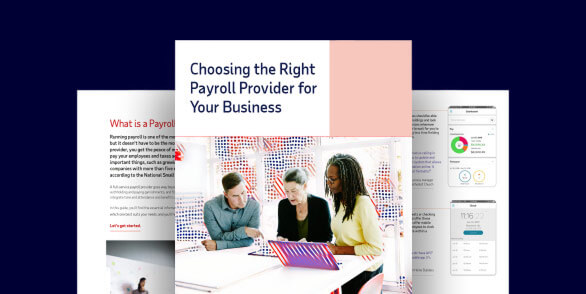Small business owners may not give much thought to accounting for payroll. They’re often too busy perfecting a product or service and establishing a customer base. But if they have employees and plan on paying them without third-party assistance, they will need to understand accounting payroll basics. This knowledge can mean the difference between a thriving business poised for growth and one that is crushed under the weight of expensive penalties.
Table of Contents
What Is payroll accounting?
Payroll accounting is how employers record, track and analyze their payroll transactions. This process helps employers manage their payroll-related costs and safeguard their assets. Payroll accounting records may also be required in the event of an audit.
Expenses that may fall under payroll accounting
Of all the operating expenses businesses incur, payroll costs are usually the largest. They include:
- Employee compensation
- Employer payroll taxes
- Employee and employer benefit contributions
What is a liability?
When a business incurs an obligation to pay another entity, it’s known as a liability. Two of the most common liabilities in accounting for payroll are wages and taxes payable.
Payroll debits and credits
Debits and credits are used to record payroll transactions in double-entry accounting systems. For every debit, there must be a corresponding credit of equal amount to maintain balance.
In payroll accounting, debits increase asset and expense accounts and decrease liability accounts. They are always listed on the left side of the payroll journal.
Credits have the opposite effect of debits on payroll transactions. They decrease asset and expense accounts and increase liability accounts. Credits are always listed on the right side of journal entries.
What is a payroll journal entry?
Accountants use journal entries to record payroll transactions, including employee compensation, payroll taxes and other voluntary or involuntary deductions (e.g., benefits contributions, wage garnishments, union dues, etc.). There are three types of entries – initial or primary payroll entry, accrued wages entry and manual payments entry.
Primary payroll entry
The primary payroll entry records employees’ gross wages and payroll deductions. It also includes the employer’s share of payroll taxes.
Accrued wages entry
Wages owed to employees but not paid by the end of an accounting period are recorded in the accrued wages entry. In the next accounting period, the accrued wages entry is reversed and replaced by the primary payroll entry.
Manual payments entry
Terminations and pay adjustments may necessitate paying employees in between the regularly scheduled pay periods. The manual payments entry is used to record these off-cycle transactions.
Challenges of payroll accounting
The biggest payroll-related challenge for most small business owners is a lack of in-house resources. These individuals already wear many hats and don’t have the time to become payroll experts. In many cases, hiring a dedicated accountant or payroll professional is not economically feasible either. This lack of in-house expertise can leave a small business vulnerable to ever-changing federal and state employment laws.
The importance of payroll accounting
Improper payroll accounting methods can result in erroneous payments to employees and government agencies. The employer may be subject to penalties and interest for these infractions. Payroll accounting records are also incorporated into financial statements, which portray a company’s net worth and provide additional information that may interest investors.
How to record payroll
In the initial payroll entry, expenses for employee gross compensation and the employer’s portion of payroll taxes are listed as debits. Liabilities, such as tax withholdings payable to government agencies, are listed as credits. Once all taxes have been paid, the liability accounts are debited, and the cash account is credited. Employers should consult an accountant or tax attorney for more specific instructions.
How to do payroll accounting with the help of payroll software
Payroll software helps eliminate mistakes by automatically calculating wages, deductions and tax liabilities. Sometimes, the payroll provider will also pay and file taxes with government agencies on the employer’s behalf.
Records of these transactions are available within the payroll solution for employers to download for record keeping purposes. Employers can access the information through various payroll reports, which they might run when responding to audits, investigating errors or providing documentation for other purposes.
Frequently asked questions about small business payroll and accounting
What is the main purpose of payroll accounting?
The primary purpose of payroll accounting is to record each transaction that occurs during a pay cycle. Journal entries typically include compensation payable to employees, taxes payable to government agencies and other related details. Tracking and analyzing this information helps employers reconcile employee payments, taxes and other payroll deductions.
How do you process payroll accounting?
Payroll accounting requires a basic understanding of double-entry accounting systems and how debits and credits are used to track changes in assets, liabilities and expenses. Employers must also have a payroll journal to document each payroll transaction manually. This process can be labor-intensive, which is why many business owners opt for payroll software instead.
How to do payroll as a bookkeeper?
Traditional bookkeeping methods using journals and ledger entries may suffice for some small businesses running payroll. Each entry includes a description of the payroll transaction and the account affected (e.g., expense, liability or asset). Debits are always listed on the left and credits on the right.
This guide is intended to be used as a starting point in analyzing accounting and payroll software for small businesses and is not a comprehensive resource of requirements. It offers practical information concerning the subject matter and is provided with the understanding that ADP is not rendering legal or tax advice or other professional services.




